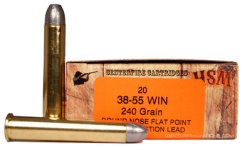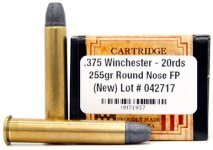.../
/...About pressure liabilities. In the late 70s Winchester blundered with their "Big Bore 94". Their "new" cartridge had very similar dimensions as the old BP .38-55 round , and could be chambered, and fired (with catastrophic results ), in a old 1894 in .35-55.
.38-55 Winchester.
.375 Winchester.
Actually no, Winchester got it exactly right and did so very intentionally.
Let's look at the dimensions:
The bore of the .38-55 Winchester has a .379" groove and .373" land diameter.
In comparison the .375 Win used a .366" land diameter and a .376" groove diameter.
In addition, the chamber diameter at the case mouth of the .375 Win is .4015" in diameter with a diameter of .3785" at the start of the throat, at 2.1229" with a straight section to 2.1929" before starting a very long and gradual taper to bore diameter.
In contrast in the .38-55 the case mouth diameter is .3949" in diameter, tapering to .3943" at the throat.
The distance to the start of the throat in the .38-55 is also 2.1182", compared to 2.1229" in the .375 Win. That makes the .375 Win very large and long throated compared to the .38-55, particularly in regard to it's smaller .375" bullet diameter.
----
What this all means is that a proud new BB 94 owner, upon discovering that .375 Win ammo was very hard to find (which was precisely the case and one of the ,major reasons the .375 Win failed commercially), could shoot factory .38-55 ammo in the .375 Winchester BB 94 without blowing anything up.
Why? Because the .375 Win's generous chamber (.4015") and throat (.3785") dimensions allowed the longer .38-55 cartridge to chamber with ample room for the case to release the larger .378-.379" diameter bullet, which in turn would enter the throat and be sized down .002" to .003" to the .376" groove diameter in the long tapered throat.
That sizing of the bullet does potentially increase pressure in the case above the 30,000 CUP limit for the .38-55, but it is still well under the ability of the modern .38-55 case to contain. (The .30-30 case walls are identical and it operates at 38,000 CUP.) Just as importantly, the pressure is well under the 52,000 CUP pressure limit of the .375 Win round so there is zero risk to the rifle.
Conversely, if the proud owner of a trusty .38-55 happened upon some .375 Win ammo and fired it, the shorter 2.080" case would easily chamber in the longer 2.118" .38-55 chamber and when fired, the smaller .375" bullet would essentially rattle down the .3943" throat, and into the .379" bore with minimal engraving (.001") from the .373" rifling. Which means the pressure generated in the chamber would remain within the .38-55's 30,000 CUP limit.
Winchester didn't authorize it, and warned against it for legal reasons, but they were smart enough to know it would occur on a regular basis and designed the .375 Win round and chamber accordingly.
-----
If larger .380-.381" cast bullets are used in the .375 Win, the larger but softer bullet still sizes in the long throat. The problem with cast bullets in the .375 Win however are related to the large .4015" throat. Ideally with a cast bullet the cartridge will be no more than about .001" smaller than the chamber at the mouth - just enough for a clean release, and the bullet will be about .001" larger than the throat, providing rapid obturation to prevent gas cutting. Those conditions are just not met in the .375 Win. It also has a much faster rifling twist rate, which tends to increase leading with cast bullets.
----
Below are my .38-55 Model 94 rifle and my .375 Win BB94 carbine.
I enjoy shooting them both. I save dedicated jacketed .375" bullets and both Winchester and Starline .375 Win brass for full pressure .375 Win loads. However I also occasionally shoot .38-55 cast bullet hand loads in my .375 Win, but it's rare as they shoot much more accurately in my .38-55.





